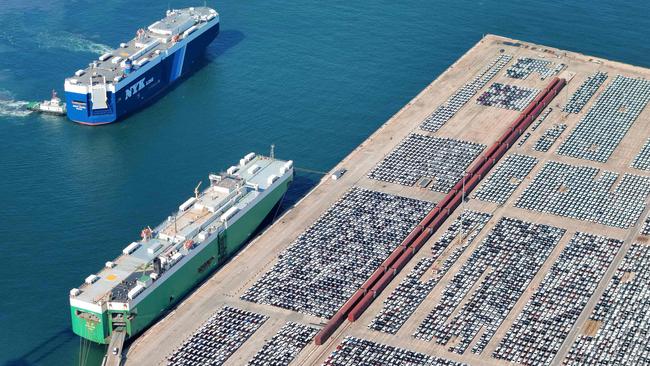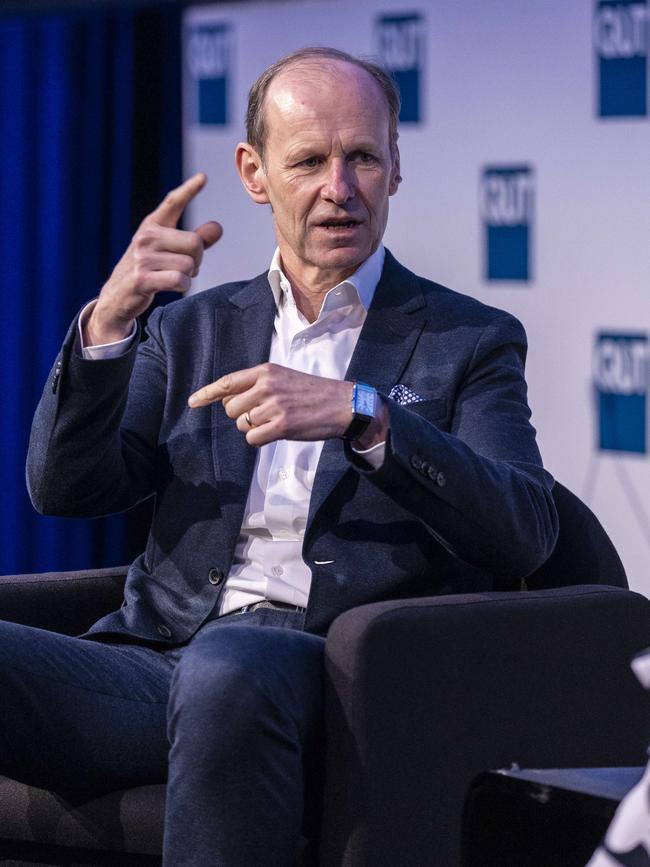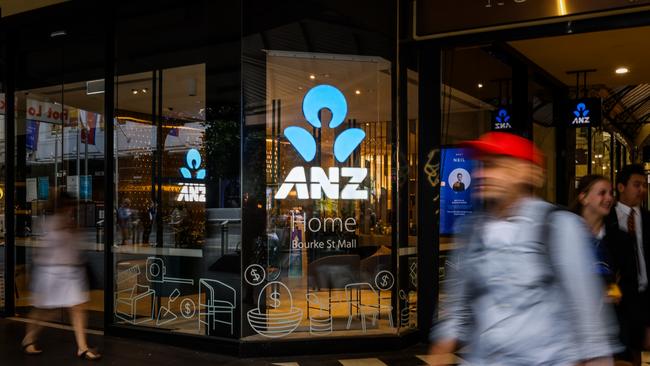These are the big themes that chief executive Raphael Arndt is shaping the fund around and which see him starting to break away from the investment pack.
If he is right, Australia’s influential sovereign wealth fund is set to see windfall returns as others fall away, setting it up for an ever bigger pool that can be reinvested over the coming decade.

But if Arndt is wrong, it could represent years of sub-par performance – or at worst, negative returns – meaning the giant fund will struggle to meet long-term targets set down by Canberra.
Since the Covid-19 pandemic, the Future Fund boss has been making significant changes to how it invests its cash, essentially to prepare for higher inflation and a more volatile world.
The biggest changes are the paring back of exposure to shares and equities, while boosting holdings of bonds and alternative assets such as private equity. That shift will continue into the coming financial year. Here the biggest bet is that rates – particularly in the US – will remain high. Markets remain divided on that view with some pricing in that US rate cuts are coming by mid-next year. And this has been driving the recent surge in shares.
Arndt’s measures are adding defence into the portfolio, but says it shouldn’t be seen as coming at a cost to the performance of the fund.
“Basically we are saying we’re taking less risk with more return,” Arndt tells The Australian.
“As we’ve been saying for some time while the very favourable investment conditions of recent years have reversed and markets are not adequately pricing the risks associated with that.”
With inflation holding higher for longer and even potential for interest rates to move higher “then equities must reprice,” Arndt says.
“You can’t have cash rate in the US at 5.5 per cent and a long-term bond rate roughly the same and the equities will stay where they are – that’s really expensive.
“It just doesn’t make sense unless you think that the (US) Federal Reserve is about to cut interest rates aggressively and we just don’t think that’s likely.”
Major shift
Last December, Arndt’s Future Fund issued a landmark position paper signalling a major shift in how the fund was set to invest. His team had concluded the era of ultra-low inflation was over and would push up the risk curve by taking on more private equity, moving directly into commodities such as gold while eyeing further big-ticket infrastructure buyouts.
The paper threw out the long-term view of a 60-40 investment approach, a principle that 60 per cent of investments should be in growth assets and 40 per cent in defensives such as bonds or infrastructure.
Arndt’s team delivered a return of 6 per cent for the past financial year, this was below its target of 10 per cent and marks the second year running it has fallen below target (like everyone it was hit with the massive equities sell off in late 2021).
While its returns are not directly comparable, for context Australia’s big four industry funds delivered annualised returns in excess of 8 per cent.
Arndt says the difference is the lighter exposure to equities than most big super funds, but that is a deliberate point.

Arndt points out the Future Fund targets, that are CPI-plus up to 5 per cent over the long-term, were set in a world where inflation was never expected to hit an annualised rate of 8 per cent.
“Clearly the world’s changed,” Arndt says. His focus is for the fund is to deliver higher, safe, returns over the longer term.
“We’ve got the portfolio configured now where we are leading into the future, we’re not worrying about one-year returns or repricing dynamics, or runs in the equity market.
“We’re really focused on the world which is going to exist over the next 10 years.”
Arndt’s team too has been steadily pulling back its exposure to China. He says there’s been a lot of signs for some time that China is going to become harder to invest in, particularly given its interventions with domestic industries and rising geopolitical tensions. However, the current slowdown – led by the property market there – represents a broader risk for the Australian economy. China’s post-Covid recovery has failed to materialise, which is seeing growth there stall.
One area where the Future Fund was an early mover is artificial intelligence, with as much as $3bn of direct investments through its venture capital arm. It has another $10bn in indirect investments of companies with exposure to AI.
These holdings weren’t repriced to capture the big boom, in the financial 2023 numbers, although they should be seen in the December half.
Too safe?
ANZ’s boss Shayne Elliott has made a significant point about a shift underway inside Australia’s banks. They have become too safe.
Years of slowly rising regulation that has become more prescriptive about who, what, when and how banks can lend is stifling access to funds through the economy.
It has come to the point where the relentless push to create an ever safer bank meant that banks were instinctively flocking to the lowest of risk customers.

In some cases, rules in place simply prevented them from making lending decisions – a 55-year-old first homebuyer for example, or a start-up that requires two years of cash flow. This was creating a problem where access to credit is increasingly just for the wealthy.
Bank executives have repeatedly spoken of frustration at not being able to lend to “good borrowers” because rules covering risk and consumer credit prevent them from doing so.
It seems an anathema at this point of the economic cycle that a senior bank boss like Elliott is talking about banks becoming less safe, but another way of looking at it: What is the cost of our banks becoming too safe?
Elliott’s comments were made during a speech in Brisbane earlier this week and reported by my colleague Glen Norris, where the ANZ boss said laws were preventing banks from lending to a whole range of potential borrowers and this means the economy is becoming less dynamic. The bank should be on the hook for making the decisions around risk, he added.
Westpac famously took ASIC’s interpretation of responsible lending rules to court and won the so-called “wagyu and shiraz” case. But the regulator has still taken a tough view over banks applying responsible lending rules that relate to mortgage customers to their small business customers.
Just as for years central banks undershot inflation targets, creating an imbalance, banks today are vastly undershooting their own internal targets for lending losses.
If they moved up the risk curve – even slightly – it will be a given there will be more bad loans, and it will be a cost to bank shareholders.
However, it also means for every one bad loan, there could be hundreds of other mortgages or business loans that can be written and repaid. Over the longer term, this means a more productive economy.
Tolerance for risk
Bankers have a tolerance for risk and despite the most aggressive run up in interest rates in decades, there are still near record-low lending losses sitting on their balance sheets. There are at a lot of headlines about mortgage stress, but it’s not in the big banks.
Record low unemployment levels certainly help, this also shows regulations around keeping banks safe and minimising losses introduced since the global financial crisis or the Hayne banking royal commission are working.
The unusually low losses could also be interpreted as banks not lending to their potential capacity. At ANZ, stressed mortgage losses are just 0.6 per cent of its entire mortgage book, and this has moved up fractionally in the past year. Before the Covid-19 pandemic hit – when the economy was functioning normally – ANZ’s mortgage lending losses were running at 1.25 per cent.

At the same time, ANZ’s credit card lending losses – the first to go during any downturn – haven’t budged from record lows in the past 12 months. While the absolute numbers are slightly different among all the major banks, the trend is identical.
Lending losses, however, are rising among more lightly regulated non-bank lenders and buy now, pay later players. The big banks want to get back some of their customers and have signalled they are prepared to take on the risk.
Earlier Wednesday, Future Fund chairman and former treasurer Peter Costello said: “The banks are not the most entrepreneurial organisations in Australia. Never have been. I think this is where we do need competition from new entrants and regional players to keep the bank’s feet to the fire.”
Elliott’s comments are controversial but have urged a bigger shift in thinking around the role of banks in an economy, particularly as Australia faces a longer-term downgrade in productivity.
Governments should be rightfully cautious about the broader risk to an economy when a bank gets into trouble or worse still collapses. This can be a devastating blow and, like was seen through the global financial crisis, massive bailouts to protect depositors saddled governments with debt while economies across Europe fell into a grinding recession.
John Lonsdale, the chairman of bank regulator APRA, this week said the focus for his agency was to continue to ensure Australia’s banks are well-placed to withstand severe shocks and remain a source of strength for the community.
johnstone@theaustralian.com.au






Australia’s $256bn Future Fund is taking a super-sized bet that inflation will stay higher for longer, that shares are overpriced and China’s rapid slowdown represents a bigger risk to Australia than many are anticipating.